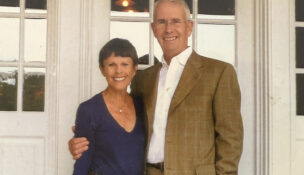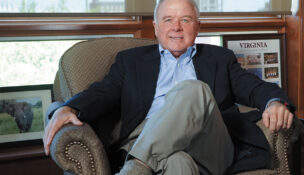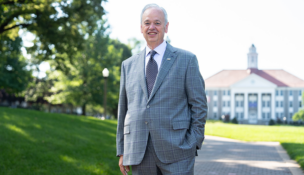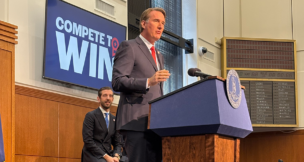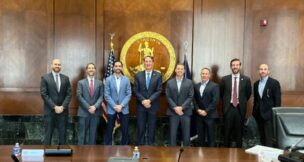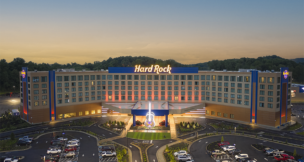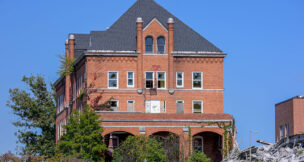Take a look inside George Mason’s high-tech science and engineering labs
University unveils new Life Sciences and Engineering Building in Manassas

A George Mason student takes part in a virtual reality lab at the new Life Sciences and Engineering Building. Photo by Evan Cantwell/George Mason University

A George Mason student takes part in a virtual reality lab at the new Life Sciences and Engineering Building. Photo by Evan Cantwell/George Mason University
Take a look inside George Mason’s high-tech science and engineering labs
University unveils new Life Sciences and Engineering Building in Manassas
In a third-floor lab at George Mason University’s new, $107 million Life Sciences and Engineering Building in Manassas, students will dissect and study the effects of decomposition on human remains. A few floors away, their peers may dangle from harnesses while wearing sensors to research gaits while others test fly an autonomous blimp in a two-story aviary.
Open to students since January, George Mason’s 132,000-square-foot state-of-the-art interdisciplinary lab and research space was unveiled to the public Thursday. Part of the university’s Science and Technology Campus, it brings together students from George Mason’s colleges of science, education and human development, engineering and computing, as well as visual and performing arts and offers classrooms, collaboration space and 30 labs for a range of hands-on training in the sciences and technology, including athletics and kinesiology, chemistry, robotics, autonomous vehicles, and forensic sciences.
Those labs and hands-on opportunities include a first-floor wind tunnel, additive manufacturing spaces and even morgue storage, where forensic sciences students may stash their research subjects — including those plucked from George Mason’s nearby five-acre “body farm,” where people donate their bodies for decomposition studies in the name of science.
Mary Ellen O’Toole, a former FBI profiler who directs George Mason’s forensics science program, said the new space is a vast improvement over what the program had at the university’s main Fairfax headquarters, where it shared an old, cramped chemistry lab. Now the program has access to five shared labs where forensic research can be performed, including cadaver space, along with 3D imaging cameras that can help map out crime scenes in minute details.
“Forensics in 20 years is not going to be what forensics is today,” O’Toole said. “It’s going to be different. We’d like to think we’re preparing our students for that.”

George Mason’s newest space aims to push forward scientific research, and it also serves as an anchor for Prince William County’s sprawling Innovation Park, which focuses on life sciences and technology and includes a growing town center, offering housing, retail and an entertainment district. In 2022, the county opened its Northern Virginia Bioscience Center in the park, offering space for expanding businesses and startups as Prince William focuses efforts on becoming a stronghold for the life sciences.
It also comes as state universities expand their presence in Northern Virginia, tapping into the region’s growth in tech.
In December, George Mason opened its $250 million, 345,000-square-foot Fuse tech hub at its Mason Square campus in Arlington County, which will focus on undergraduate and graduate education in technology and offer commercial space to industry partners. In February, Virginia Tech’s $302 million Innovation Campus opened in Alexandria’s growing National Landing neighborhood, offering graduate student programming in artificial intelligence, quantum computing and more.
About 4,500 students study at the Manassas campus, with some living there, said George Mason President Gregory Washington, though more student housing is needed, he added. Washington compares the Innovation Park development to nearby Reston and Tysons in Fairfax County, both of which have quickly urbanized into dense, mixed-use communities. He also notes George Mason’s growing status, including being named as a top 50 public university by U.S. News and World Report in recent years. With more than 40,000 students, George Mason is Virginia’s largest public university and is known for its diverse student body and accessibility to first-generation students.
“We needed more labs on campus so that students can do more experimental learning, more hands-on,” Washington said. “This has been a godsend to be able to put all these labs here.”
Christina Winn, executive director of Prince William’s Department of Economic Development and Tourism, told Virginia Business in a statement that GMU‘s expansion, as well as the developing Innovation Park, “boosts our region’s edge. With top faculty and state-of-the-art labs, GMU is growing the talent pipeline and strengthening our position as a hub for innovation, entrepreneurship, and opportunity in Northern Virginia.”
s


